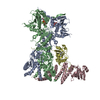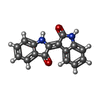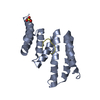+ Open data
Open data
- Basic information
Basic information
| Entry | Database: PDB / ID: 7zub | ||||||||||||
|---|---|---|---|---|---|---|---|---|---|---|---|---|---|
| Title | Cryo-EM structure of the indirubin-bound Hsp90-XAP2-AHR complex | ||||||||||||
 Components Components |
| ||||||||||||
 Keywords Keywords | GENE REGULATION / complex / nuclear receptor / chemical pollutants / detoxification / cancer | ||||||||||||
| Function / homology |  Function and homology information Function and homology informationGAF domain binding / cytosolic aryl hydrocarbon receptor complex / regulation of B cell proliferation / cellular response to 2,3,7,8-tetrachlorodibenzodioxine / HSP90-CDC37 chaperone complex / regulation of adaptive immune response / nuclear aryl hydrocarbon receptor complex / negative regulation of proteasomal protein catabolic process / Aryl hydrocarbon receptor signalling / cellular response to molecule of bacterial origin ...GAF domain binding / cytosolic aryl hydrocarbon receptor complex / regulation of B cell proliferation / cellular response to 2,3,7,8-tetrachlorodibenzodioxine / HSP90-CDC37 chaperone complex / regulation of adaptive immune response / nuclear aryl hydrocarbon receptor complex / negative regulation of proteasomal protein catabolic process / Aryl hydrocarbon receptor signalling / cellular response to molecule of bacterial origin / aryl hydrocarbon receptor complex / negative regulation of T cell mediated immune response to tumor cell / histone methyltransferase binding / dynein axonemal particle / receptor ligand inhibitor activity / Xenobiotics / ATP-dependent protein binding / positive regulation of protein localization to cell surface / Phase I - Functionalization of compounds / protein kinase regulator activity / protein folding chaperone complex / protein targeting to mitochondrion / blood vessel development / Respiratory syncytial virus genome replication / telomerase holoenzyme complex assembly / positive regulation of transforming growth factor beta receptor signaling pathway / Uptake and function of diphtheria toxin / dendritic growth cone / TPR domain binding / E-box binding / Assembly and release of respiratory syncytial virus (RSV) virions / aryl hydrocarbon receptor binding / TFIID-class transcription factor complex binding / The NLRP3 inflammasome / protein phosphatase activator activity / Sema3A PAK dependent Axon repulsion / regulation of protein ubiquitination / HSF1-dependent transactivation / response to unfolded protein / Endogenous sterols / HSF1 activation / telomere maintenance via telomerase / Attenuation phase / chaperone-mediated protein complex assembly / axonal growth cone / RHOBTB2 GTPase cycle / Purinergic signaling in leishmaniasis infection / cis-regulatory region sequence-specific DNA binding / : / supramolecular fiber organization / DNA polymerase binding / heat shock protein binding / negative regulation of proteasomal ubiquitin-dependent protein catabolic process / protein folding chaperone / peptide binding / cellular response to forskolin / xenobiotic metabolic process / cellular response to interleukin-4 / Gene and protein expression by JAK-STAT signaling after Interleukin-12 stimulation / ESR-mediated signaling / TBP-class protein binding / HSP90 chaperone cycle for steroid hormone receptors (SHR) in the presence of ligand / cellular response to cAMP / protein maturation / placenta development / nitric-oxide synthase regulator activity / positive regulation of cell differentiation / peptidyl-prolyl cis-trans isomerase activity / Hsp90 protein binding / circadian regulation of gene expression / ATP-dependent protein folding chaperone / PPARA activates gene expression / DDX58/IFIH1-mediated induction of interferon-alpha/beta / Regulation of actin dynamics for phagocytic cup formation / response to toxic substance / negative regulation of inflammatory response / kinase binding / tau protein binding / transcription coactivator binding / histone deacetylase binding / nuclear receptor activity / Chaperone Mediated Autophagy / positive regulation of nitric oxide biosynthetic process / sequence-specific double-stranded DNA binding / disordered domain specific binding / MHC class II protein complex binding / The role of GTSE1 in G2/M progression after G2 checkpoint / melanosome / unfolded protein binding / protein folding / double-stranded RNA binding / regulation of protein localization / cellular response to heat / regulation of gene expression / secretory granule lumen / transcription regulator complex / Estrogen-dependent gene expression / ficolin-1-rich granule lumen / Potential therapeutics for SARS / RNA polymerase II-specific DNA-binding transcription factor binding Similarity search - Function | ||||||||||||
| Biological species |  Homo sapiens (human) Homo sapiens (human) | ||||||||||||
| Method | ELECTRON MICROSCOPY / single particle reconstruction / cryo EM / Resolution: 2.85 Å | ||||||||||||
 Authors Authors | Gruszczyk, J. / Savva, C.G. / Lai-Kee-Him, J. / Bous, J. / Ancelin, A. / Kwong, H.S. / Grandvuillemin, L. / Bourguet, W. | ||||||||||||
| Funding support | European Union,  France, 3items France, 3items
| ||||||||||||
 Citation Citation |  Journal: Nat Commun / Year: 2022 Journal: Nat Commun / Year: 2022Title: Cryo-EM structure of the agonist-bound Hsp90-XAP2-AHR cytosolic complex. Authors: Jakub Gruszczyk / Loïc Grandvuillemin / Josephine Lai-Kee-Him / Matteo Paloni / Christos G Savva / Pierre Germain / Marina Grimaldi / Abdelhay Boulahtouf / Hok-Sau Kwong / Julien Bous / ...Authors: Jakub Gruszczyk / Loïc Grandvuillemin / Josephine Lai-Kee-Him / Matteo Paloni / Christos G Savva / Pierre Germain / Marina Grimaldi / Abdelhay Boulahtouf / Hok-Sau Kwong / Julien Bous / Aurélie Ancelin / Cherine Bechara / Alessandro Barducci / Patrick Balaguer / William Bourguet /    Abstract: The aryl hydrocarbon receptor (AHR) is a ligand-dependent transcription factor that mediates a broad spectrum of (patho)physiological processes in response to numerous substances including ...The aryl hydrocarbon receptor (AHR) is a ligand-dependent transcription factor that mediates a broad spectrum of (patho)physiological processes in response to numerous substances including pollutants, natural products and metabolites. However, the scarcity of structural data precludes understanding of how AHR is activated by such diverse compounds. Our 2.85 Å structure of the human indirubin-bound AHR complex with the chaperone Hsp90 and the co-chaperone XAP2, reported herein, reveals a closed conformation Hsp90 dimer with AHR threaded through its lumen and XAP2 serving as a brace. Importantly, we disclose the long-awaited structure of the AHR PAS-B domain revealing a unique organisation of the ligand-binding pocket and the structural determinants of ligand-binding specificity and promiscuity of the receptor. By providing structural details of the molecular initiating event leading to AHR activation, our study rationalises almost forty years of biochemical data and provides a framework for future mechanistic studies and structure-guided drug design. | ||||||||||||
| History |
|
- Structure visualization
Structure visualization
| Structure viewer | Molecule:  Molmil Molmil Jmol/JSmol Jmol/JSmol |
|---|
- Downloads & links
Downloads & links
- Download
Download
| PDBx/mmCIF format |  7zub.cif.gz 7zub.cif.gz | 674 KB | Display |  PDBx/mmCIF format PDBx/mmCIF format |
|---|---|---|---|---|
| PDB format |  pdb7zub.ent.gz pdb7zub.ent.gz | 555.2 KB | Display |  PDB format PDB format |
| PDBx/mmJSON format |  7zub.json.gz 7zub.json.gz | Tree view |  PDBx/mmJSON format PDBx/mmJSON format | |
| Others |  Other downloads Other downloads |
-Validation report
| Summary document |  7zub_validation.pdf.gz 7zub_validation.pdf.gz | 1.3 MB | Display |  wwPDB validaton report wwPDB validaton report |
|---|---|---|---|---|
| Full document |  7zub_full_validation.pdf.gz 7zub_full_validation.pdf.gz | 1.3 MB | Display | |
| Data in XML |  7zub_validation.xml.gz 7zub_validation.xml.gz | 59.1 KB | Display | |
| Data in CIF |  7zub_validation.cif.gz 7zub_validation.cif.gz | 89.8 KB | Display | |
| Arichive directory |  https://data.pdbj.org/pub/pdb/validation_reports/zu/7zub https://data.pdbj.org/pub/pdb/validation_reports/zu/7zub ftp://data.pdbj.org/pub/pdb/validation_reports/zu/7zub ftp://data.pdbj.org/pub/pdb/validation_reports/zu/7zub | HTTPS FTP |
-Related structure data
| Related structure data |  14971MC M: map data used to model this data C: citing same article ( |
|---|---|
| Similar structure data | Similarity search - Function & homology  F&H Search F&H Search |
- Links
Links
- Assembly
Assembly
| Deposited unit | 
|
|---|---|
| 1 |
|
- Components
Components
-Protein , 3 types, 4 molecules ABCD
| #1: Protein | Mass: 84213.141 Da / Num. of mol.: 2 Source method: isolated from a genetically manipulated source Source: (gene. exp.)  Homo sapiens (human) / Gene: HSP90AB1, HSP90B, HSPC2, HSPCB / Production host: Homo sapiens (human) / Gene: HSP90AB1, HSP90B, HSPC2, HSPCB / Production host:  #2: Protein | | Mass: 37691.047 Da / Num. of mol.: 1 Source method: isolated from a genetically manipulated source Source: (gene. exp.)  Homo sapiens (human) / Gene: AIP, XAP2 / Production host: Homo sapiens (human) / Gene: AIP, XAP2 / Production host:  #3: Protein | | Mass: 49767.879 Da / Num. of mol.: 1 Source method: isolated from a genetically manipulated source Source: (gene. exp.)  Homo sapiens (human) / Gene: AHR, BHLHE76 / Production host: Homo sapiens (human) / Gene: AHR, BHLHE76 / Production host:  |
|---|
-Non-polymers , 4 types, 7 molecules 






| #4: Chemical | | #5: Chemical | #6: Chemical | #7: Chemical | ChemComp-JY6 / ( | |
|---|
-Details
| Has ligand of interest | Y |
|---|
-Experimental details
-Experiment
| Experiment | Method: ELECTRON MICROSCOPY |
|---|---|
| EM experiment | Aggregation state: PARTICLE / 3D reconstruction method: single particle reconstruction |
- Sample preparation
Sample preparation
| Component | Name: Hsp90-XAP2-AHR complex / Type: COMPLEX / Entity ID: #1-#3 / Source: RECOMBINANT | |||||||||||||||||||||||||||||||||||
|---|---|---|---|---|---|---|---|---|---|---|---|---|---|---|---|---|---|---|---|---|---|---|---|---|---|---|---|---|---|---|---|---|---|---|---|---|
| Molecular weight | Value: 0.256 MDa / Experimental value: YES | |||||||||||||||||||||||||||||||||||
| Source (natural) | Organism:  Homo sapiens (human) Homo sapiens (human) | |||||||||||||||||||||||||||||||||||
| Source (recombinant) | Organism:  | |||||||||||||||||||||||||||||||||||
| Buffer solution | pH: 7 | |||||||||||||||||||||||||||||||||||
| Buffer component |
| |||||||||||||||||||||||||||||||||||
| Specimen | Conc.: 0.2 mg/ml / Embedding applied: NO / Shadowing applied: NO / Staining applied: NO / Vitrification applied: YES | |||||||||||||||||||||||||||||||||||
| Specimen support | Grid material: GOLD / Grid mesh size: 300 divisions/in. / Grid type: C-flat-1.2/1.3 | |||||||||||||||||||||||||||||||||||
| Vitrification | Instrument: FEI VITROBOT MARK IV / Cryogen name: ETHANE / Humidity: 100 % / Chamber temperature: 295 K |
- Electron microscopy imaging
Electron microscopy imaging
| Experimental equipment |  Model: Titan Krios / Image courtesy: FEI Company |
|---|---|
| Microscopy | Model: FEI TITAN KRIOS |
| Electron gun | Electron source:  FIELD EMISSION GUN / Accelerating voltage: 300 kV / Illumination mode: FLOOD BEAM FIELD EMISSION GUN / Accelerating voltage: 300 kV / Illumination mode: FLOOD BEAM |
| Electron lens | Mode: BRIGHT FIELD / Nominal magnification: 81000 X / Nominal defocus max: 1500 nm / Nominal defocus min: 800 nm / Cs: 2.7 mm / C2 aperture diameter: 50 µm / Alignment procedure: COMA FREE |
| Specimen holder | Cryogen: NITROGEN / Specimen holder model: FEI TITAN KRIOS AUTOGRID HOLDER |
| Image recording | Average exposure time: 3 sec. / Electron dose: 1.1 e/Å2 / Film or detector model: GATAN K3 (6k x 4k) / Num. of grids imaged: 1 / Num. of real images: 9300 |
| EM imaging optics | Energyfilter name: GIF Bioquantum / Energyfilter slit width: 20 eV |
- Processing
Processing
| Software | Name: PHENIX / Version: 1.20_4459: / Classification: refinement | ||||||||||||||||||||||||||||||||||||||||||||
|---|---|---|---|---|---|---|---|---|---|---|---|---|---|---|---|---|---|---|---|---|---|---|---|---|---|---|---|---|---|---|---|---|---|---|---|---|---|---|---|---|---|---|---|---|---|
| EM software |
| ||||||||||||||||||||||||||||||||||||||||||||
| CTF correction | Type: PHASE FLIPPING ONLY | ||||||||||||||||||||||||||||||||||||||||||||
| Particle selection | Num. of particles selected: 11546649 | ||||||||||||||||||||||||||||||||||||||||||||
| Symmetry | Point symmetry: C1 (asymmetric) | ||||||||||||||||||||||||||||||||||||||||||||
| 3D reconstruction | Resolution: 2.85 Å / Resolution method: FSC 0.143 CUT-OFF / Num. of particles: 678724 / Num. of class averages: 1 / Symmetry type: POINT | ||||||||||||||||||||||||||||||||||||||||||||
| Atomic model building | Protocol: FLEXIBLE FIT / Space: REAL | ||||||||||||||||||||||||||||||||||||||||||||
| Atomic model building |
|
 Movie
Movie Controller
Controller




 PDBj
PDBj





































